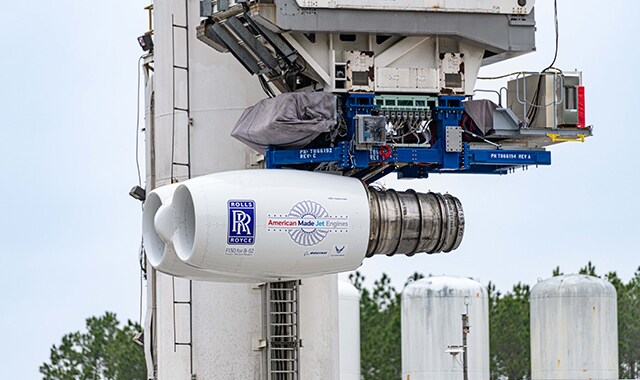Aerospace
Rolls-Royce has begun testing F130 engines for the United States Air Force B-52 fleet at the NASA Stennis

Rolls-Royce (LSE: RR., ADR: RYCEY) today announces it has launched F130 engine testing at the company’s outdoor test facility at the NASA Stennis Space Center in Mississippi, U.S. Rolls-Royce F130 engines were selected by the United States Air Force to replace the existing powerplants in the B-52 fleet, with over 600 new engine deliveries expected. This milestone test program is the first time F130 engines have been tested in the dual-pod engine configuration of the B-52 aircraft. Each B-52 aircraft has eight engines in four pods.
The engine testing will focus on crosswind aerodynamic flow as well as confirming the successful operation of the engine’s digital controls system. Early results from the testing have been very positive with additional test data to be analyzed over the next several months.
Rolls-Royce is collaborating very closely with the Air Force and Boeing, which is managing the overall engine integration and B-52 aircraft modernization program. The new engines will extend the life of the B-52 aircraft by 30 years. F130 engines are so durable they are expected to remain on the wing for the remainder of the aircraft’s life.
F130 engines will be manufactured, assembled, and tested at Rolls-Royce facilities in Indianapolis, the company’s largest production facility in the U.S. Rolls-Royce has invested $1 Billion in recent years to completely modernize manufacturing and testing facilities in Indiana, as well as for advanced technology.
F130 engines were selected for the B-52 by the Air Force in September 2021 following a competitive selection process. The F130 is derived from the Rolls-Royce BR family of commercial engines, with over 30 million hours of operation and a high-reliability rate. It’s a proven, dependable engine with a fuel-efficient design.

Aerospace
Boeing Transfers Rocket Stage to NASA, Paving Way for Human Moon Mission

Boeing has achieved a significant milestone by providing NASA with the second core stage of the Space Launch System (SLS) rocket.
This crucial component, crafted at NASA’s Michoud Assembly Facility (MAF), is set to propel the Artemis II crew into lunar orbit, marking humanity’s return to deep space after a 50-year hiatus.
The monumental Boeing-built rocket stage, the largest element of the Artemis II mission, will embark on a journey aboard the Pegasus barge, traveling 900 miles to NASA’s Kennedy Space Center.
Comparison of two legendary aircraft B777x vs B747 aircraft:Click here
Upon arrival, it will be meticulously integrated with other essential Artemis II components, including the upper stage, solid rocket boosters, and NASA’s Orion spacecraft within the iconic Vehicle Assembly Building. This intricate integration process is a vital step toward the eagerly anticipated Artemis II launch, slated for 2025.
“Boeing-built products helped land humankind on the moon in 1969, and we’re proud to continue that legacy through the Artemis generation,” remarked Dave Dutcher, vice president and program manager for Boeing’s SLS program. “Together, with NASA and our industry partners and suppliers, we are building the world’s most capable rocket and paving the way to deep space through America’s rocket factory in New Orleans.”
NASA, Lockheed Martin Reveal X-59 Quiet Supersonic Aircraft:Click here
The delivery of Core Stage 2 marks a significant achievement in the evolution of the SLS rocket. Towering over 200 feet and powered by four RS-25 engines, this core stage, coupled with two solid-fueled booster rockets, will generate a staggering 8.8 million pounds of thrust. This immense power is crucial to launching Artemis II and future missions into the vast expanse of space.
The SLS rocket stands unparalleled in its capability to transport both crew and substantial cargo to the moon and beyond in a single launch. Its extraordinary capacity will facilitate the delivery of human-rated spacecraft, habitats, and scientific missions to destinations including the moon and Mars, ushering in a new era of space exploration.
-

 Travel1 week ago
Travel1 week agoAir India to Expand US Operations with Three New Routes After a Decade
-

 Travel2 weeks ago
Travel2 weeks agoWhy We Should Avoid These Stamps in a Passport
-

 Airlines1 month ago
Airlines1 month agoInvestigations Reveal Fake Chinese Titanium in Boeing and Airbus Jets
-

 Tech4 weeks ago
Tech4 weeks agoChina’s CATL Plans 1,800-Mile Electric Plane Launch by 2027
-

 Airport3 days ago
Airport3 days agoTop 10 Largest Airports in the World by Size
-

 Aerospace4 weeks ago
Aerospace4 weeks agoChina’s Fighter Jets Turn Wings into Autonomous Drones
-

 Airlines4 days ago
Airlines4 days agoAir India Rolls Out A350s for Delhi-New York JFK and Newark Routes
-

 Defence3 weeks ago
Defence3 weeks agoBoeing Enhances Chinook with New Engines and Block II Upgrades at $96 Million







